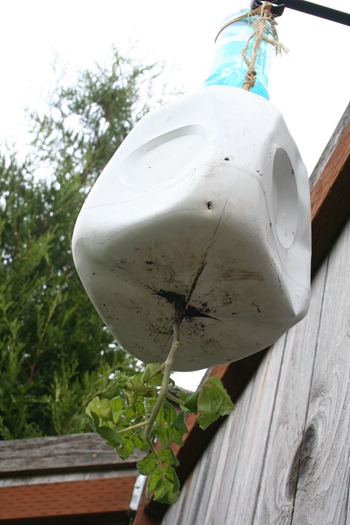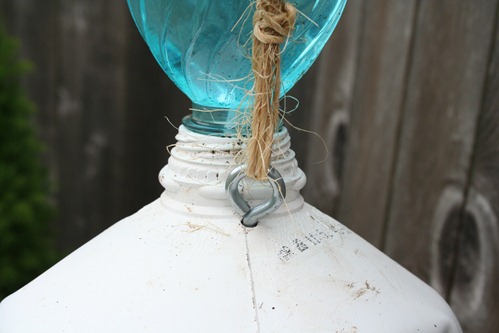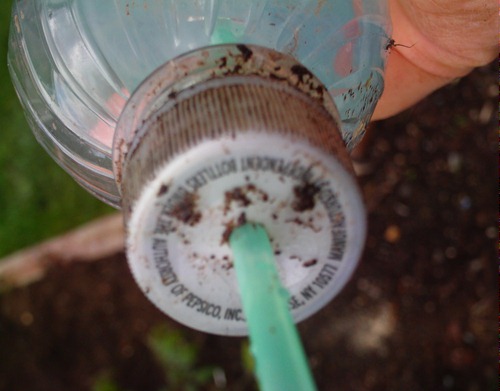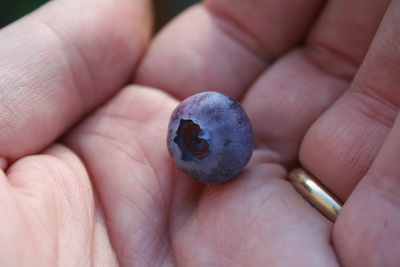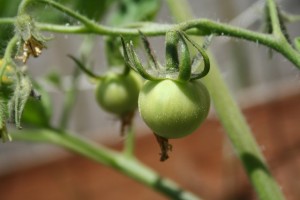1 Gallon Milk carton upside down tomato planter
14 years ago cheap, peppers, tomato, upside down planter, water
I wanted to see if (how much) my yields varied by allowing more volume of dirt in my homemade tomato planter, so I made this variation with the same type and size “Husky Cherry” seedling I am using in my 2-liter planter version.
The build for this one is also very simple:
- I started with an organic milk carton given it was already opaque, but if you have the non-organic variety you will want to paint or cover the outside with duct tape.
- Next cut or drill a 1/2 inch hole on the bottom of the milk carton, this will be where the stem of the plant will fit through.
- Cut four slits out from the center of the 1/2 inch hole to make it easier to insert the plant into the planter.
- Insert plant through the bottom.
- Fill with soil (mix of 1 part peat moss/coconut coir)
- Finally drill a hole and feed though eyelet secured with a nut from the back side
Now here is where you can stop or you can go with the advanced auto-watering option.
Materials Needed:
- 20 ounce water bottle
- plastic straw
- sponge
Build Instructions:
- Drill hole just large enough to barely be able to pull the straw through
- Cut a 1 inch long piece of sponge just wide enough to be able to slip inside the straw.
- Fill with water and screw on cap and insert into top of planter
As the dirt dries it will also dry out the sponge which will release water and repeat as necessary. This works in a very similar concept as a Aqua Globe you may have seen advertised on TV.
Tags: cheap, garden seeds, organic vegetables, outdoor plants, tomato plants, upside down tomato planter, vegetables
How to prevent weeds in your garden
14.5 years ago organic, weed prevention, weeds
I doubt there is anyone who enjoys pulling weeds, though now at the end of the season is a great time to do some preventive measures to prevent new growth next season.
Kill your weeds early: The sooner you pull your weeds the easier it is to keep up with them. In addition, if you pick the weeds before the mature and flower and drop seeds you will save a ton of time pulling weeds for every one of those seeds that drop. Call me old fashioned but I normally skip the whole herbicide method and just pull the weeds by hand. Not only does your lawn or garden immediately look better, there is no coming back to see if the weeds need another dose of spray and the whole environmental part of keeping some chemicals out of our water system.
Mulch: This is one I didn’t completely understand until I had been gardening for a while. I for one never have found “beauty bark” beautiful and have always preferred the more natural look and benefits of fertile soil. But that is entirely why you want to use a mulch such as ground bark, straw, pine needles, leaves, newspaper, rubber bark, or even some old carpet. This helps prevent weeds in twp ways. First, it blocks light from the potential little weed seedlings to make their way to the surface. Second, they are not fertile mediums to grow seeds, which is exactly what you are looking for for your large flower beds which like to create good crops of weeds. As a final benefit they help insulate and hold water down for the plants you want to thrive having great growth and eventually shading out those “poor” weed seedlings. just 3-4 inches during the fall and your back should be bending over much less next spring.
If you are thinking, “What about my vegetable garden? I want seeds to be able to grow in there next year.” For your vegetable garden I highly recommend chopped leaves and a vegetable garden mulch. If you happen to have a leaf blower/vacuum that will chop them up all you need to do is empty those bags in a thin 1-2 inch layer across your garden. I used to have one of these though accidentally sucked up a rock which didn’t “chop” well and broke it so the alternate method I use is the following. Bag your leaves throughout the fall and once the leaves stop falling dump them out in a long row in your yard. Then use you lawnmower with bagger attachment and run them over until they are all chopped up. You can also do this more frequently during the fall but I find this a good time to use all the gas in the lawnmower before the end of winter feeling more like I am doing something more meaning other than just letting the mower sit there until it burns off the remaining fuel. With these leaves on the surface you smother any weed seeds and also block out all light to the soil. When spring time comes you simply work in the decomposed leaves into the soil and your garden has a head start with some good organic matter.
Pre-emergent weed control: For some parts of your yard like your lawn mulching is not really an options so to protect against pesky weeds like one of my personally loathing weed, annual bluegrass. Which grows and seeds so close to the ground it is nearly impossible to pull the plants to prevent the spreading. Pre-emergent herbicides is the solution to this problem. Pre-emergent herbicides work by preventing weed seeds from germination by inhibiting cell division in their tiny root system. Given these plants are annuals a successful application can rid you yard of these weeds until they eventually blower over from a neighbors. Pre-emergent herbicides can be purchased as a chemical or the organic method is applying glutton corn meal which normally can be purchased from your local feed store. One thing to remember is that this also will prevent you normal grass seed from germinating as well so be sure to time your application after with with enough lead time to allow the pre-emergent from wearing off.
Grow a cover crop: Growing a cover crop has two major benefits to your garden. Various legumes, grasses, and buckwheat make good options for for cover crops to plants while you garden is empty. First it creates a natural shade from the sun making it hard (or impossible) for seedlings are the surface to survive under their great shadows. Second it provides organic mater as “green manure” to add nutrients to your soil. One recommendation is to make sure you do a little research on the plant you choose as a cover crop, if you accidentally wait too long to “harvest” your cover crop it could go to seed and you may have an entirely new weed problem on your hands.
Cook the soil: When all else fails apply some black plastic (thicker the better) covering to your planting beds and let them “cook” throughout the fall/winter. Like mulch this will prevent any light and most water from entering the areas covered. This will essentially cook the soil killing any weeds, seeds, fungi, or anything else living in that area. Though this is very effective in eliminating weeds and disease from your soil it also kills everything else including good bacteria that your friendly worms like to visit your garden, so you soil may take sometime to recover and return to becoming living soil. I would recommend this method as a last result when the previous methods have proven to be completely unsuccessful.
Just for some positive outlook, you can also think of weeds as green manure assuming you are adding these to your compost, so even out of control they still can decompose and help your garden…
Tags: compost, garden seeds, organic vegetables, outdoor plants, vegetables, worms
How to save pumpkin seeds
14.5 years ago harvest, pumpkin, seed saving, seeds
The kids and I carved several pumpkins this year but we waited carve the three pumpkins we grew in our backyard until Halloween since these were the seeds I wanted to save for planting next year. First, I know exactly how these pumpkins were grow, organically and free of any pesticides. Second, I was able to let these pumpkins grow undisturbed until the day I picked the seeds, so the seeds should definitely be mature.
The process is very simple, while getting the “goo” as my 5-year-old would say out of the pumpkin set the seeds aside and add to a colander. Give them a good rinse and remove any orange “goo” that may have snuck in. Pat dry with a towel and let the seeds dry on wax or parchment paper for a couple days. Once they are dry to touch put them layered on a paper sack and let them dry for a few weeks until putting them in homemade seed packets until the are ready for next year.
If you have way too many seeds than you need (I know I do) you can also use the great recipe to roast some of you extra seeds as a snack:
CVG’s Roasted Pumpkin Seeds
- Extra pumpkin seeds
- 1/2 tsp oil
- 1/2 tsp of Worchester sauce
- 1/4 tsp of seasoning salt
Directions: Add ingredients to bowl and mix well. Lay on a single layer on a cookie sheet and bake at 325 for about 25 minutes being sure to flip the seeds after about 10 minutes. Eat as soon as you can without burning your mouth.
Tags: cheap, garden seeds, organic vegetables, outdoor plants, vegetables
Growing blueberries
14.5 years ago blueberry, cheap
If it were up to me every part of my landscaping would be edible. Though my homeowners association may disagree with me but blueberry bushes looks just as nice as any ornamental plant/bush when you visit the nursery with the obvious bonus of free food.
When selecting a blueberry bush, unless you are very patient spend about $10 a plant and get some more established ones (about 1/2 inch stem) You can get the two for $10 plants from your local Home Depot but you won’t be eating blueberries for a couple years. With the larger plants you should pinch off the blossoms to get better growth for the first couple years but I opt to getting my reward now instead of later and enjoy the handful of berries the young plants can produce.
When it comes to plant selection there are a large number of species to choose from with varying fruit size and harvest timing. I would recommend getting varieties that have varying maturity dates so you can enjoy those blueberries for a longer period of time. When I got my first two plants I went with Toro and Berkeley. The Berkeley is a very popular bush given it produces average size berries great for muffins/pancakes/cereal or the occasional snack with a mid-late harvest. The Toro on the other hand produces large (almost grape size) berries which are great for jams and snacks though bit of a mouthful for muffins. If you are curious of other varieties here is a great resource.
I have heard differing opinions on whether you need to have different species to successfully produce fruit after a little research I found this article which explains that blueberries are capable of pollinating with a single species, though studies have shown that having more varieties can produce larger and earlier fruits. So if you have a favorite variety you can go crazy with the single plant though a little diversity seems to always be a good thing.
When it comes to pest control the biggest pest is birds. You can control them by laying some netting on the plants, though in my personal opinion that just gets in the way of me getting my snacks so I opt for the lazy approach and just plant more plants and share with “neighbors”. Worse case I end up with a backyard with some bushes that look much nicer than my current evergreens, and I always can take up bird watching.
One of the most important parts to being successful with your little blueberry plants is soil preparation. The plants need to have an acidic soil and their roots like to remain moist, but not drowning in water. Given my area has an abundance of clay in my backyard, I naturally do not have either of these requirements. To give the plants a head start I dug a 1 foot wide/deep hole and filled it with peat moss and mixed with a few handfuls of compost. Not only will this retain water well, but the peat moss is also naturally acidic and will be a nice haven for a large family of worms in the next few years to add some awesome natural fertilizer (worm castings) Last I purchased I box of organic blueberry fertilizer which provides the primary and trace minerals as well as help keep the acidity of the soil up. I simply followed the directions on the box and watered the plants when there was a couple of days without rain.
Now some of you might be thinking, “hey it is fall why are you talking about growing blueberries” Well this is the “Cheap Vegetable Gardener, right now is a great time to visit your local nursery to pick up some of their “old overgrown” blueberry plants at bargain prices which you can plant now and enjoy some delicious berries next spring/summer.
Tags: birds, cheap, compost, led, organic vegetables, outdoor plants, vegetables, worms
Do have have to follow the directions on the back of my seed packet?
14.6 years ago garden planning, seeds
Though the advice on the back of a seed packet gives some great information, they are recommendations and their advice may not exactly apply to your garden.
First is row spacing, many times you read something like “plant seeds 3 inches apart in rows 1 foot apart” This brings up some immediate logic of why can the plants be 3 inches apart one way but 12 inches in another. This sort of thinking the premise for intensive gardening techniques such as square foot gardening. This is where instead of growing your plants in rows you plant them in a grid pattern making best use of your growing space.
Now even these spacing requirements are actually optional. All plants compete for resources to survive. This can be sunlight (or even shade from sunlight), nutrients, water, airflow, etc. Depending on the quality of your soil and frequency of watering you can push the limits of your growing space. Assuming you add some fresh compost easy season and possibly do some side dressing with an organic fertilizer like fish emulsion or alfalfa pellets you can easily reduce this space and still have high yields. I did just that with my cherry tomato plants whose seed packet is above. I planted these about a foot apart and got great growth and yields.
One other factor is how you grow. If I was growing my tomatoes in cages my foot space probably wouldn’t even be technically possible but since I grew them on a netting this allowed for spread out much more naturally and provide adequate sunlight and airflow. Keep this in mind when growing sprawling plants such as cucumbers and squash using some vertical space can free up the valuable growing space on the ground.
The last factor depends on when you are going to pick them. If you are growing onions to simply pick as green onions you don’t have to give then the 3-4 inches needed for their bulbs to grow. You could easily plant an inch apart since you are going to pick them before they are competing for resources. A similar idea is growing for micro greens, plant picked when just a few inches tall.
Though I wouldn’t say to completely ignore the back of your seed packets, just make sure to use it as a guide not a requirement.
Tags: compost, garden seeds, organic vegetables, outdoor plants, tomato plants
How to fertilize/side dress tomatoes/peppers in your garden
14.8 years ago alfalfa pellets, compost, fertilizer, peppers, tomato
When your fruiting plants are flowering and bearing fruit this is a good time to give them a little extra boost. Though you don’t want to throw any old fertilizer at them at this point. You want them to get the nutrients they need to produce high yields of produce, though you don’t want to shock them with an abundance of nitrogen to stimulate new vegetative growth when you would rather the plant expend its energy making you food.
The solution to this problem is to provide your plants with a low dose of balanced fertilizer. I couple of my favorites are compost and alfalfa pellets applied every couple weeks while the plants are blooming/fruiting. This ensures the plants have all the nutrients they be lacking without throwing the plant into a growth spurt.
If you have a little extra time take the compost and add some water and let it sit in the sun for several hours and water or spray onto the foliage for a great dose of compost tea.
If you forgot to apply a little bone meal when you planted your peppers/tomatoes this is also a good time to sprinkle a handful under your plants and work into the couple inches of soil to provide your plants with a boost of phosphorous and also a little calcium to help prevent blossom end rot.
Hopefully with these tips you can help your green tomatoes turn into bright delicious red tomatoes.
If you want to learn more about the chemistry of organic fertilizers I have a whole post on that subject
Tags: alfalfa pellets, cheap, compost, organic vegetables, outdoor plants, pepper plants, tomato plants, vegetables
